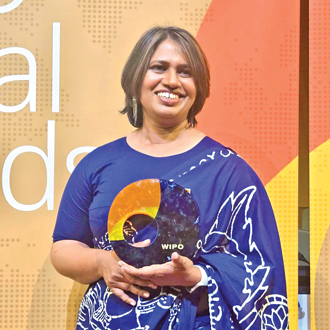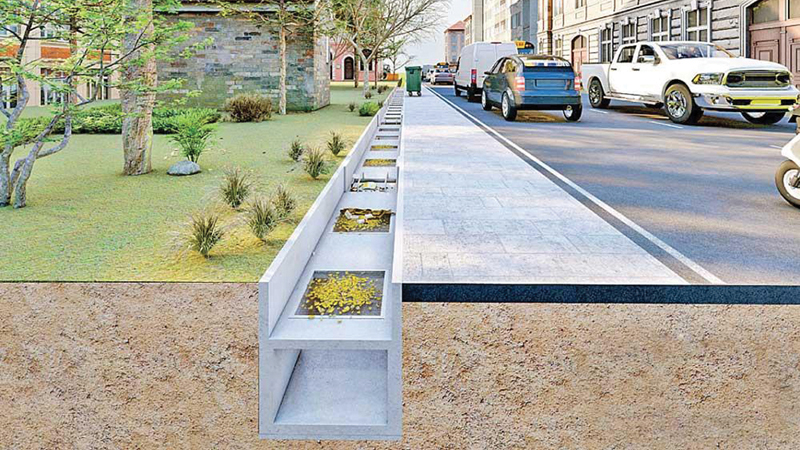 The world recently turned its attention to a ground-breaking innovation hailing from our very own shores. Dr. Nadeesha Chandrasena, a brilliant Sri Lankan, and her team, “Urban Inventors,” clinched a prestigious global award for their ingenious “Smart Drain” concept. This isn’t just a win for Dr. Chandrasena; it’s a testament to Sri Lanka’s burgeoning potential in addressing global challenges through innovative solutions. But beyond the international accolades, a crucial question lingers: can this revolutionary technology, designed to combat urban flooding and waste accumulation, truly take root and flourish in the complex landscape of Sri Lankan cities?
The world recently turned its attention to a ground-breaking innovation hailing from our very own shores. Dr. Nadeesha Chandrasena, a brilliant Sri Lankan, and her team, “Urban Inventors,” clinched a prestigious global award for their ingenious “Smart Drain” concept. This isn’t just a win for Dr. Chandrasena; it’s a testament to Sri Lanka’s burgeoning potential in addressing global challenges through innovative solutions. But beyond the international accolades, a crucial question lingers: can this revolutionary technology, designed to combat urban flooding and waste accumulation, truly take root and flourish in the complex landscape of Sri Lankan cities?
Smart Drain technology
Imagine a drain that doesn’t just channel water, but actively prevents itself from clogging. That’s the essence of Smart Drain technology. Unlike conventional drainage systems that are prone to blockages from solid waste, the Smart Drain boasts a unique, dual-layer design. Its innovative structure acts as a sophisticated filter, trapping solid materials like plastic and debris while allowing stormwater to flow freely and uninterrupted.
But it’s more than just a clever physical design. Dr. Chandrasena’s Smart Drain concept integrates real-time monitoring capabilities, employing sensors that can detect water levels and flow rates. This allows the Municipal authorities to be alerted to potential issues before they escalate into full-blown floods. It’s a proactive approach to urban water management, aiming to prevent the chaos and damage that come with overflowing drains.
Global recognition
 The Smart Drain concept, developed by Dr. Nadeesha Chandrasena and her team at Urban Inventors, was recently named one of the ten global winners of the 2025 WIPO Global Awards. This highly coveted award is presented by the World Intellectual Property Organization (WIPO), a United Nations agency dedicated to fostering intellectual property, innovation, and creativity worldwide.
The Smart Drain concept, developed by Dr. Nadeesha Chandrasena and her team at Urban Inventors, was recently named one of the ten global winners of the 2025 WIPO Global Awards. This highly coveted award is presented by the World Intellectual Property Organization (WIPO), a United Nations agency dedicated to fostering intellectual property, innovation, and creativity worldwide.
The WIPO Global Awards recognise startups and Small and Medium-sized Enterprises (SMEs) that have successfully leveraged intellectual property to create significant economic and social impact. This year, Smart Drain was selected from a record 780 applications from 95 countries, standing out for its innovative response to the escalating challenge of urban flooding, particularly in densely populated areas. This recognition places Sri Lanka firmly on the global map for sustainable infrastructure solutions.
The journey so far: A glimpse into the future
Dr. Nadeesha Chandrasena, who shed light on the current progress and future vision for the Smart Drain told the Sunday Observer that they are doing two sites. “What we are doing is installing the smart part as a breadboard drainage hint to the existing ones. Then for the single U-shaped drain, we are making the upper part as a drain with two channels in the basin. We have now selected the settings site.
The settings are done. The relevant technical drawings are done. Now what we are doing is manufacturing the relevant top layer. That manufacturing part is done by Access Engineering. Then we sign an agreement with Access Engineering for that manufacturing part. Currently, this Smart Drain is at that stage. After signing the agreement with Access Engineering, we do manufacturing.”
“Also, this is not something that needs to be done in every city. We provide solutions to cities with circulation problems. Then, there is no point in creating such Smart Drains in places where there are no such problems. This is like when a valve is blocked due to calcium or cholesterol deposits in a person’s body, a bypass surgery has to be performed to open that block. This is how we introduce the concept of Smart Drain. We implement this Smart Drain technology only in specific places where the drain system in cities is not working properly. It is like opening that block when a valve in the heart is blocked and putting up a tent. There is no need to build a Smart Drain like building a highway in the entire country.
As an initiative or stage one of this Smart Drain, we are introducing this Smart Drain as a micro skills suggestion for the places where there are problems in the next 10 years. In stage two, this Smart Drain is integrated with a new construction. In that, we tell them to use the dual channel Smart Drain instead of the U-shaped drain.
So, we have introduced cost-effective technology for it. We are conducting research to introduce cost-effective materials. Then, in stage two, a new introduction is made to new constructions in a modulated manner. Then, in stage three, cities around the world are asked to adapt this technology, which is city-specific, meaning that the design for Colombo is not the same as for Galle. That means we provide a drain design that is compatible with the geographical and social conditions of the city in question. It is a process of about a hundred years to get to stage two and three. The first ten years are stage one. Then stage two is new construction. We think that it will take another generation to fully adapt this to a city. We are introducing this Smart Drain as a generational infrastructure.”
“Currently, countries such as Bangladesh, Kenya, India and Vietnam have requested us to come to that stage to fix the problems in the stage one of this Smart Drain concept, that is, to build a pilot project and come to that stage. So, we are currently focusing on building this in the relevant cities first and making it successful. Only then will we move on to the next stage. We may fail in some places. Because this is a new technology.
We hope to implement this and see where we fail, identify those places and fix them and move forward. When infrastructure like this is introduced, it cannot be installed all at once. We do not approve of that. This should be implemented especially based on the socio-economic and geographical situation of a city. There are many problems identified in urban planning in Sri Lanka. I will not work on all of those problems. I hope to work within the scope of subjects that I have identified, learned, and are special to me.”
The Sri Lankan urban maze
While the Smart Drain’s potential is undeniable, the question of its widespread implementation in Sri Lanka requires a pragmatic look at our existing urban planning challenges. Sri Lankan cities, particularly Colombo, grapple with a myriad of issues that have historically hindered effective infrastructure development.
One of the most pressing concerns is unplanned urbanisation and encroachment. Over decades, rapid and often unregulated construction has encroached upon natural drainage paths and flood plains. This has severely compromised the natural ability of land to absorb excess water, making cities highly susceptible to flooding even after moderate rainfall. The existing U-shaped drains, a legacy of older planning, are often inadequate to handle the increased runoff, and their open design makes them convenient receptacles for solid waste.
Poor waste management practices are deeply ingrained. Littering, improper disposal of household and commercial waste, and a lack of civic responsibility contribute significantly to drain blockages. Even the most sophisticated “smart” drain would face an uphill battle if the very source of its problem – accumulated waste – isn’t addressed at a societal level.
Lack of coordinated urban planning and governance across different authorities also presents a hurdle. Drainage systems often span multiple administrative boundaries, requiring seamless collaboration between Local Councils, Municipal bodies, and national agencies. Historically, a fragmented approach has led to disjointed efforts and a lack of holistic solutions.
Finally, resource constraints and maintenance culture are critical factors. Implementing a widespread “smart” infrastructure project requires significant upfront investment and, crucially, consistent long-term maintenance. While the Smart Drain promises to reduce maintenance costs by preventing major blockages, a culture of regular upkeep and swift response to alerts would be essential for its sustained effectiveness.
A ray of hope
So, can Smart Drain technology be implemented in Sri Lanka? The answer, like most complex questions, isn’t a simple yes or no. Dr. Chandrasena’s vision of a staged, city-specific implementation, focusing on problematic areas first, is a realistic and promising approach. It acknowledges that a country-wide overhaul isn’t feasible and that solutions must be tailored to local geographical and socio-economic conditions.
The success of the initial pilot projects, the agreement with local manufacturing powerhouses like Access Engineering, and the growing international interest are all positive indicators. However, for the Smpart Drain to truly transform Sri Lankan cities, it will require more than just technological innovation. It will demand a parallel evolution in urban planning policies, a concerted effort towards improved waste management, and a renewed sense of civic responsibility.
The Smart Drain offers a powerful tool, a sophisticated bypass surgery for our clogged urban arteries. But just like a patient needs to adopt healthier habits after surgery, our cities need systemic changes to truly embrace this innovation and usher in an era of cleaner, flood-resilient urban living. Dr. Chandrasena’s Smart Drain is a beacon of hope, and with a focused, collaborative, and persistent effort, it has the potential to redefine the future of urban infrastructure in Sri Lanka, one smart drain at a time.








